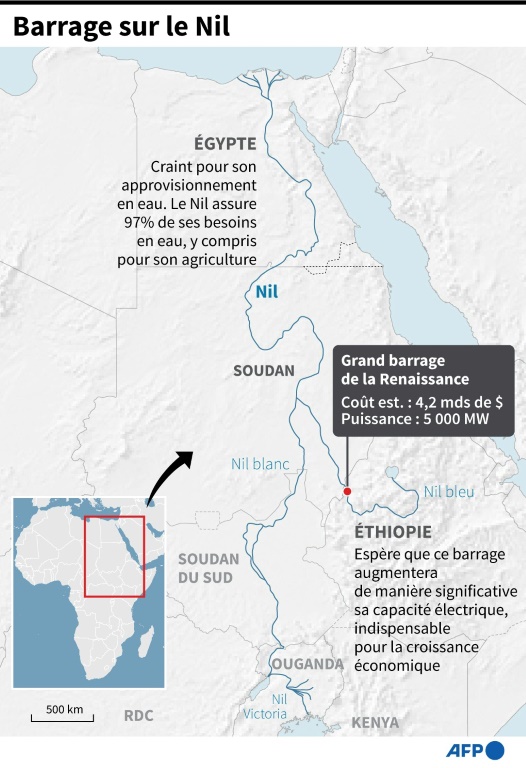The Gerd under construction on December 26, 2019 (AFP/Archives/EDUARDO SOTERAS)
Ethiopia will start generating power from its controversial Nile dam on Sunday, Ethiopian officials told AFP on Saturday.
“Tomorrow (Sunday) will take place the first production of electricity from the Grand Dam of the Renaissance” (Gerd), an Ethiopian government official told AFP.
The information was confirmed by a second Ethiopian official, the two men speaking on condition of anonymity in the absence of official communication on this subject from the Ethiopian authorities.
“This new source of electricity from the Gerd comes at the right time to revive an economy undermined by the combination of a devastating war, rising fuel prices and the covid-19 pandemic”, judged Addisu Lashitew, expert from the Brookings Institution in Washington.
Since the launch of the project in 2011, the Gerd (“Grand Ethiopian Renaissance Dam”) has been a serious bone of contention with Sudan and Egypt, both of which depend on the Nile for their water resources.

Dam on the Nile (AFP/Janis LATVELS)
Cairo invokes a “historic right” on the river, guaranteed since a treaty signed in 1929 between Egypt and Sudan, then represented by Great Britain, a colonial power. Egypt had obtained a right of veto on the construction of projects on the river.
In 1959, after an agreement with Khartoum on water sharing, Egypt had allocated a quota of 66% of the annual flow of the Nile, against 22% for Sudan.
Not being a party to these agreements, Ethiopia never considered itself bound by them and, in 2010, a new treaty signed by the countries of the Nile basin, despite the opposition of Egypt and Sudan , removes the Egyptian right of veto and authorizes irrigation projects and hydroelectric dams.
Seized last summer, the UN had recommended to the three countries to continue their talks under the aegis of the African Union (AU). Cairo and Khartoum, worried about their water supply, had asked Addis Ababa to stop filling the dam.
Ethiopia had nevertheless proceeded last July to the second phase of filling the dam, announced as one of the largest in Africa with an initial production target of 6,500 megawatts, revised downwards to 5,000 MW, for an estimated total cost to 4.2 billion dollars (3.7 billion euros).
Located on the Blue Nile, about thirty kilometers from the Sudanese border, the Great Renaissance Dam is 1.8 kilometers long and 145 meters high.
© 2022 AFP
Did you like this article ? Share it with your friends with the buttons below.




